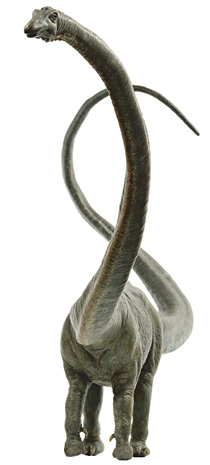DK Science: Examining Footprints
It has been said that the footprints of a dinosaur can tell us more about the dinosaur than its skeleton. This is because footprints are a record of the living, moving animal, while the skeleton is simply the remains of its dead body. The footprints of any animal can tell you a number of things about it, such as its size, and how it stood, ran, or walked. By comparing footprints with dinosaur skeletons, scientists are able to get a clearer picture of what dinosaurs were really like. A set of tracks can reveal more about dinosaur behaviour, and can even give an idea of its speed. Some of the largest footprints are made by brontosaurs. These can be over 1 m (3 ft) long and 0.7 m (2 ft) across.
When analysing trackways, many different measurements are taken. The length and width of the footprint, and the trackway width, can tell us about the dinosaur’s size. The trackway width can also reveal the dinosaur’s stance. Other measurements such as pace length (distance between successive footprints), stride length (distance between prints made by the same foot), and the angle between the prints of alternate feet (pace angulation), can tell us how the animal moved.
A set of footprints can give an idea of how the animal that made them behaved. A single line of footprints suggests a loner, while several parallel trackways may mean the animal lived as part of a herd. Occasionally, we find trackways of large and small footprints together, from dinosaurs that lived in a family group. Trackways can also show carnivorous dinosaurs pursuing prey.
The size of a dinosaur can be worked out from its footprint. The key measurement is the height of the hip, which is usually estimated as about four times the length of the footprint. If there is a set of prints, it should be possible to tell whether the dinosaur walked on two legs or four, and to get a more accurate idea of the size and shape of the animal, and how it stood and moved.
If dinosaurs were like most modern reptiles, you would expect them to stand with their limbs sticking out from the sides of the body, and elbows and knees bent at right angles. This is called the sprawling stance. Or you might imagine that they walked in a semi-sprawling stance, with elbows and knees slightly bent, like modern crocodiles. However, fossil footprints are too close together to have been produced by either stance. They show that dinosaurs walked upright, like modern mammals, with vertical legs directly below the body, and supporting its weight. This erect stance was crucial to the survival of the dinosaurs. It meant that many were swift and agile on land. Also, because they did not need to use energy supporting their bodies, they were able to be very active – looking for food, for example.
How fast were the dinosaurs? We cannot be sure. It is only possible to estimate the speeds achieved by dinosaurs. Figures have been produced using mathematical calculations based on trackway measurements, leg length, weight, and several other measurements. But there are unknown factors, such as the strength of the leg bones, and the uncertainty of whether or not the dinosaurs were warm blooded – these would affect the calculations and mean that the results cannot be reliable. A few estimated speeds are shown in this chart.
To order this book direct from the publisher, visit DK's website.







